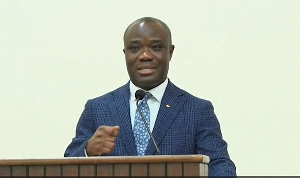Accra — The Millennium Development Goals (MDGs), founded on the 2000 Millennium Declaration, itself a document endorsed by nearly every government on Earth, have found their way into almost all the international agreements governing the flow of development aid and support throughout the global system.
Here in Ghana, MDGs are embedded into the Growth & Poverty Reduction Strategy II (GPRS II) - the successor to the Ghana Poverty Reduction Strategy I (GPRS I) -, the country's medium-term guiding-post to development (2006 - 2009). The GPRS II is in turn the basis of such international development initiatives as the HIPC (Highly Indebted Poor Country), eHIPC (enhanced HIPC), and MDRI (Multilateral Debt Relief Initiative). The same MDG-inspired plan also underlies bilateral initiatives such as the Millennium Challenge Account program in Ghana, funded by the United States.
Note that these "development initiatives" are on the above account legally binding agreements under international law, backed as they are by multilateral or bilateral treaties. In that sense, the MDGs and GPRS mechanisms have also attained legal-mandatory effect on Government of Ghana. Which is further to say that the flexibility of a government to reorder our development priorities at will is open only to the extent that it is also willing to undertake the onerous, complex, and time-consuming process of widespread consultations with local and international stakeholders to revise the GPRS frameworks, but even so it will be constrained by the thinking and philosophy behind the MDGs.
Two issues immediately arise, which are best treated separately but not necessarily at the same time. The first is that this reality mocks the rancour of partisan politics in this country: there is a "general consensus" amongst the policy making elite about "what" needs to be done in this country, but the "how" details are much too complex for the political platform and so in substitute of the hair-splitting debates that occur in other parts of the world our political class has embraced the artificial animosity of scandal mongering. All the bluster notwithstanding, there isn't much at the "strategic level" they can do different from each other, except to tinker and embroider with the inner lining of implementation, and give grand meaning to the jingle, "May the better Manager win!"
The second issue, which we address in this article, is that the MDGs are much too important to be treated like holy cows, that is: to be left undisturbed on the pastures of cowering complacency and talked about in hushed tones. However we look at it, the fact remains that we are tied to the apron strings of donors because for half a century we have preferred to talk about "structural transformation" rather than to work consistently at it. And these donors swear by the MDGs.
Whether it is the IMF's Poverty Reduction & Growth Strategy, from which we were kicked out in 2002, readmitted in 2003 after a doubling of petrol retail prices, and weaned off by Government of Ghana's commitment to create "fiscal space"; or the so-called Exogenous Shocks Facility, which it would seem our 6-man delegation to the World Bank - IMF Spring Conference have been eyeing for a while now; the MDGs remain the driving logic of eligibility.
So we need to look a bit more closely at these 8 statements of action.
Here is the list of MDGs.
1. Eradicate Extreme Poverty and hunger (Sample Target/Indicator: Halve, between 1990 and 2015, the number of people whose income is less than $1 a day)
2. Education: Achieve Universal Primary Education.
3. Gender equality: Promote Gender Equality & Empower Women.
4. Reduce Child mortality: (Sample Target: Reduce by two thirds, between 1990 and 2015, the under-five mortality rate.)
5. Improve Maternal health: (Sample Target: Reduce by three quarters, between 1990 and 2015, the maternal mortality ratio.)
6. AIDS and other diseases: Combat HIV/AIDS, malaria & other diseases (Sample Target: Have halted by 2015 and begun to reverse the spread of HIV/AIDS.)
7. Ensure Environmental sustainability
8. Develop a Global Partnership for Development
The first criticism of the MDGs framework is its internal incoherence in crucial ways, which affects measurement and therefore monitoring, evaluation and benchmarking against other policy measures.
Our own version of this criticism is principally based on the classical formulation by Attaran, Easterly and other empirical investigators who have looked at the goals within the context of their saliency in measuring progress in development. Professor Easterly for instance suggests that while the goals look perfectly sound from a global perspective, they can yield perverse insights at the country level. We are however mindful of Ghana-specific factors and therefore shapes our analysis in a manner that converts the generic criticism into a highly relevant Ghana-focused assessment.
*The first goal*
Take the first goal for instance: halve extreme poverty and hunger by 2015 in comparison with 1990. This is a relative measurement. In Ghana, as in much of sub-Saharan Africa, poverty rates were very high in 1990. To require a reduction of 50% is therefore to require a growth rate in per capita income much higher than meeting the same target would require in a region, such as Western Asia, that in 1990 had a significantly lower level of prevalence. When the effect of higher population growth (which dilutes per capita income growth) is also factored in, the GDP growth requirements for meeting the goal begin to look unrealistic. The danger here is that the goal seems set up to make Africa fail. Thus, despite almost feverish growth in many places on the continent this decade (until very recently), the MDGs still paint a picture of an Africa that is stagnant. Such an impression undermines both FDI (foreign direct investment) and technology transfer, which are the two critical inflows that transformed the Asian tigers of popular imagination.
Where it is not the goal that is designed without regard to region-specific characteristics, it is the choice of indicator. Take gender equity, for instance. Ghana's performance according to MDG3 has worsened because the number of female parliamentarians has fallen. Yet, many analysts will argue that concerning gender equity generally the reverse is the case. Government of Ghana is living up to stated intentions by appointing more women to executive decision making level than ever before. The Judiciary is likewise enjoying an era of feminine empowerment, with the appointment of the first female Chief Justice in the country's history. Indeed, the Legislature, the source of Ghana's negative ratings on MDG3, has paradoxically elected the first female Speaker.
So why did the designers confine the indicator to legislative influence, when there are three, roughly co-equal, estates of the republic? Some call it "arbitrariness" and one is compelled to concur.
It is not just the measuring effect of the goal indicator that can produce perversity. Its actual definition can also constitute arbitrariness. "Poverty" according the MDGs is defined by a benchmark of "earnings below $1 a day". It is often not made clear in the UN's reports whether this figure is to be employed as a household indicator or a per-capita indicator, perhaps in acknowledgment that widely varying sizes of households across the world will complicate measurement. Further, varying inflation rates and varying levels of purchasing power parity means that "$1" is not as simple as it sounds. Most people are aware that you could purchase a very nutritious meal in India for 50 cents (about 75 Ghana pesewas) but the same amount will only get you a mash of inedible, low-nourishment, grub in Ghana. The calculations that established "constant dollar" rates over time can therefore get more complicated than is easily appreciated. That is why the UN has had to adjust the "base year" from 1985 to 1993 and increased the "$1" figure to "$1.08". It goes on and on.
And at any rate, as Professor Easterly famously asks, why is somebody earning $0.99 as poor as someone earning $0.1" Which in MDG terms will be to ask what happens if Ghana between now and next year moves all the 39% or so people living below the "$1.08 poverty line" to an income level of $0.99, while Uganda moves 1% of its MDG-defined poor people above the $1.08 mark, while the remainder remains where it is? Well, what happens is that Uganda will be more "on course" to meet the MDGs. Professor Easterly does not put it in these terms; he asks why a movement from one level under the poverty line to a higher level isn't considered welfare progress in the same manner that movements above the line are. We believe the logic extends to comparative measurements.
*Gender equity*
The MDG on gender equity advocates - as an indicator of progress - that women move out of the agricultural sector, making no room for productivity increases in that industry that could improve rather than undermine the welfare of those who work in it, whether male or female. The justification for this choice of indicator is of course historical, since for many decades under-remunerated labour has tended to be concentrated in agriculture, with women as the principal victims. But the doctrine derived from this fact is at odds with ongoing trends in agric reform thinking across the continent. Whether the new thinking is justified or not, many countries, Ghana included, believe that agriculture could be so modernised as to ensure sustainable livelihoods for rural folk and as a means to stem rural-urban drift. Thus, an adherence to the imperatives of MDG3 would probably engender chaos in the policymaking of many poor countries, Ghana included.
It is in this context of ambiguity and ambivalence attending the link between the MDGs and national-level development strategy that we must assess both the statement that Ghana is doing well in comparison with our African neighbours and the seemingly counter-statement that the Global Economic Crisis will interfere with the country's attainment of the goals by 2015.
Neither statement, to be brutally frank, means much to development strategy reform in this country. The MDGs are a wonderful set of ideals, stated abstractly and as an exhortation to governments in Ghana and Africa to move beyond rhetoric. But as a guiding light for development strategy formulation (underline "strategy"), they are probably less useful.
The wise framers of the Growth & Poverty Reduction Strategy II (GPRS II) - the medium term development framework for Ghana that must be reviewed late this year - knew this, though they diplomatically chose to argue instead that the plan was simply not ambitious enough. Beyond the widely-shared consensus that the MDGs are minimalist criteria, they, again diplomatically, hinted that their measuring framework could not be the mechanism to monitor and analyse delivery by the public sector.
One hopes that this perspective did not stay bound to sheet, and that it actually pervades our policymaking establishment.
*Data collection*
But then the question needs to be asked about the data collection activities that seem to indicate that actual policymaking is dictated, at implementation level, by the MDG framework. We refer to such exercises as the Ghana Living Standards Survey. Beyond easy to collect and interpret data, such as under-five mortality and maternal mortality statistics obtainable from health posts, what methodology has been guiding the gathering and processing of data related to the other more complex MDGs, seeing as we have demonstrated their inherent tortuousness.
We suspect that somebody has been taken these factors for granted. Hence the complete divorce from Accra thinking witnessed at decentralised level. The folks at district level know clearly and intuitively that these "development statistics" are obfuscating true measurement, analysis and interpretation and are therefore less useful for policymaking than they are often made to seem.
If it is as we suspect, then the advice should be that all of us - in the public sector and outside it - should be generally wary of the technical papers purporting to serve as strategy guides to policy implementation in various ministries. They probably lack the necessary connection to reality, much less to the true development agenda at the local level.
It all goes back to a point we have often made: there are sufficient markers and pointers to 'what' should be done, the mess is in the 'how'. And the mess is in the 'how' because we have taken 'management' for granted and elevated 'schematics'. If our Chief Directors and Ministers of State were actually driving step-by-step implementation of agreed upon development strategies, they would have known that the blueprints are faulty because of the numerous 'slips' that would have occurred in the ordinary and routine course of their jobs.
Those readers with an experience of work in the private sector must be nodding by now. You can easily finger a bad manager by noting her inability to detect obvious misreporting. Because: wrong measurement at one level of the business always undermines delivery at another level. This is basic business strategy 101. In public management, we concede, distorted incentives make this difficult at mid-management level, which is where the troubleshooting in the private sector chiefly occurs. However that reality is counterbalanced by another: the higher stakes and incentives at top level.
Simply put, any Minister of State or Chief Director beloved by his technical people is probably not doing a good job at grilling them on reporting. In the context of this article, any senior political manager happy with just working with the GLISS does not deserve our commendation, or more bluntly, any Chief of Staff not engaged, on a frequent basis, in a phone catfight with the NDPC over MDG-guided reporting (HIPC, MDRI, MCA, GPRS etc.) is probably not earning all his salary.
*Franklin Cudjoe, Bright B. Simons & Kofi Bentil are affiliates of IMANI,named sixth most influential think tank in Africa by Foreign Policy Magazine and **www.AfricanLiberty.org*
Opinions of Tuesday, 19 May 2009
Columnist: Franklin Cudjoe


















